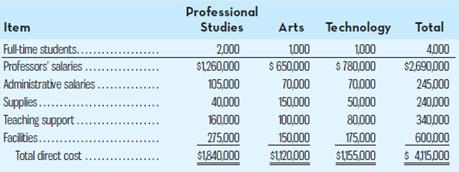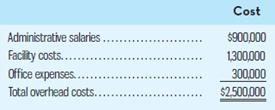Question
Kolbec Community College (KCC) has 4,000 full-time students and offers a variety of academic programs in three areas: professional studies, arts, and technology. The professional
Kolbec Community College (KCC) has 4,000 full-time students and offers a variety of academic programs in three areas: professional studies, arts, and technology. The professional studies programs prepare students for administrative and clerical jobs in a variety of professional settings, including accounting, medicine, and law. The arts program’s offerings are wide ranging and include graphic design, digital animation, culinary arts, cosmetology, and music arts. The technology programs are also varied, including information technology, medical laboratory technology, electrical engineering technology, pharmacy technology, and natural resources technology.
The chief financial officer of KCC, Lynn Jones, has consistently emphasized to other members of the senior management team the importance of understanding the costs of delivering the various academic programs. To that end, the costing system used at KCC tracks the direct costs of each program, which are shown below on an annual basis, along with the number of full-time students:

It is very important to understand the overhead costs consumed by each academic program at KCC in determining the full cost of operating the programs. Central administration at KCC allocates financial resources to academic programs based on the estimated full cost per student of delivering the program. The overhead costs at KCC are significant, totalling over 60% of direct costs. Total annual overhead costs at KCC are as follows:

Traditionally, KCC has allocated overhead costs to academic programs on the basis of the number of full-time students in each program. This approach was deemed appropriate since Jones reasoned that increasing the number of students at KCC would result in higher overhead costs (e.g., more facilities would be needed, more indirect support costs would be incurred, etc.). However, Jones is beginning to question the accuracy of the traditional approach since it results in a similar full cost per student for the arts and technology programs, which she feels doesn’t make sense. Based on her knowledge of the programs, Jones feels that the technology program is probably more expensive to deliver than the arts program, but this does not come through in the traditional costing approach.
Jones recently attended a seminar on management techniques being used by leading educational institutions that, among other topics, covered the basics of the ABC approach. She likes the idea of being able to assign indirect costs to academic programs on the basis of how much of the support activity resources are consumed by each program. If Jones’s instincts are correct in that some programs consume more resources of certain activities than others, this could have a significant impact on the overhead costs assigned to each under the ABC approach.
Upon returning to KCC, Jones decides to implement ABC. She, along with Assistant CFO James West, begins by identifying the key activities used to support the teaching programs. Rather than getting too detailed with respect to identifying activities in the initial implementation, Jones decides to keep the process manageable and comes up with six key activities. Next, based on a series of interviews with various KCC employees who work in the departments covered by the identified activities, Jones and West estimate the percentage of the total administrative, facility, and office expense resources consumed by each activity. Again, to keep the process efficient, Jones rounds all percentages to the nearest 5%, figuring that a “close enough” approach will suffice for this initial implementation and recognizing that the estimates are subjective to begin with. The results are shown below:

Working with key personnel from each of the six activities shown above, Jones and West then identify the activity measure and the quantity of that measure used for each teaching program. Fortunately, KCC implemented an enterprise resource planning system a few years ago, which is already tracking much of the information needed regarding the activity measures and the specific quantities for each academic program:

Required:
1. Using the traditional approach to assigning overhead costs to academic programs:
a. Calculate the predetermined overhead rate.
b. Assign the overhead costs to each academic program using the predetermined rate.
c. Calculate the total cost per student (direct costs plus overhead) of operating each academic program.
2. Using ABC, complete the following requirements:
a. Using Exhibit 7–7 as a guide, complete the first-stage allocation of overhead costs to academic programs.
b. Using Exhibit 7–8 as a guide, calculate the activity rates for each of the activity cost pools.
c. Using the activity rates calculated in ( b ), complete the second-stage allocation of overhead to academic programs.
3. Based on the results of (2), calculate the total cost per student (direct costs plus overhead) of operating each academic program.
4. Draft a memo to Jones explaining the key reasons for differences in the total cost per student of operating each academic program that arise between the traditional costing approach and ABC.
Professional Item Studies Arts Technology Total Fulltime students.... Professors salaries. 2000 $1260.000 4000 $2.690000 1000 1000 $ 650,000 $780,000 Administrative salaries . 105.000 70,000 70.000 245,000 Supples.. 40,000 150.000 50,000 240.000 Teaching support. 160,000 100,000 80000 340,000 275.000 $1840,000 Facities.. 150.000 175,000 600000 $ 415,000 Total direct cost $1,120,000 S155,000
Step by Step Solution
3.48 Rating (158 Votes )
There are 3 Steps involved in it
Step: 1
1a Overhead costs are allocated on the ba...
Get Instant Access to Expert-Tailored Solutions
See step-by-step solutions with expert insights and AI powered tools for academic success
Step: 2

Step: 3

Ace Your Homework with AI
Get the answers you need in no time with our AI-driven, step-by-step assistance
Get Started


